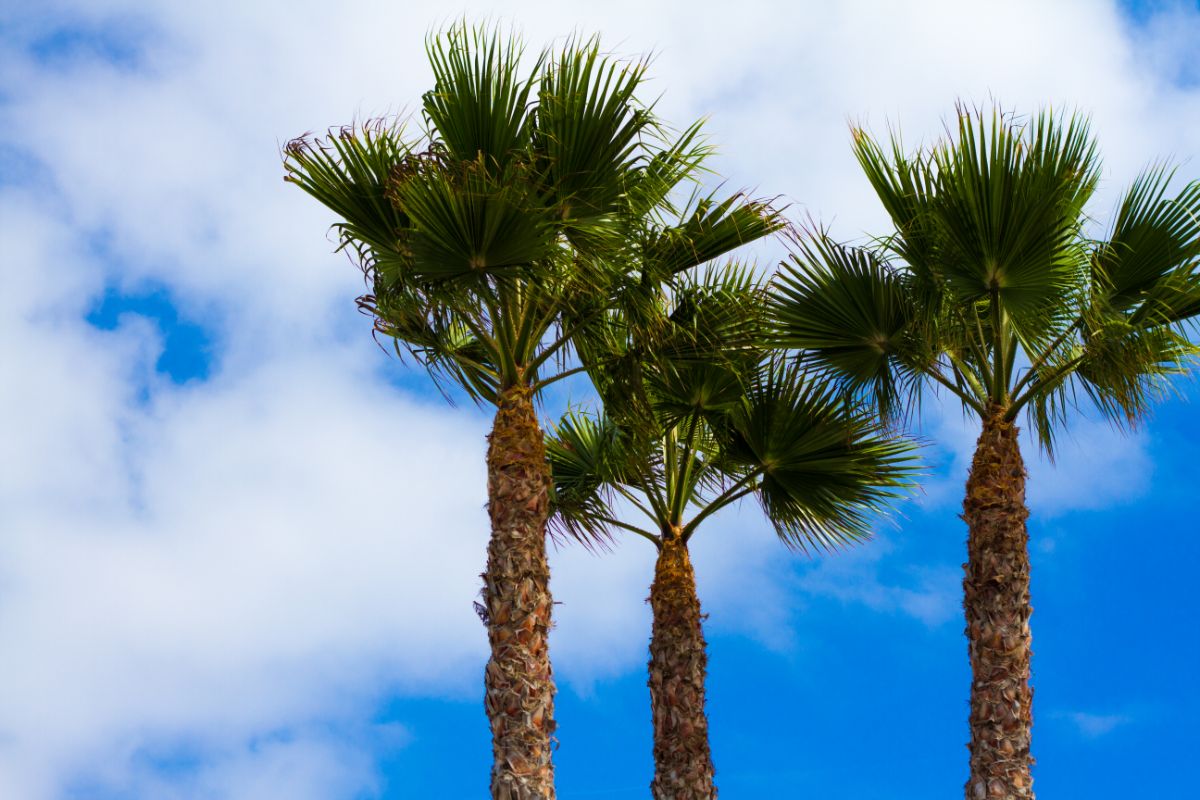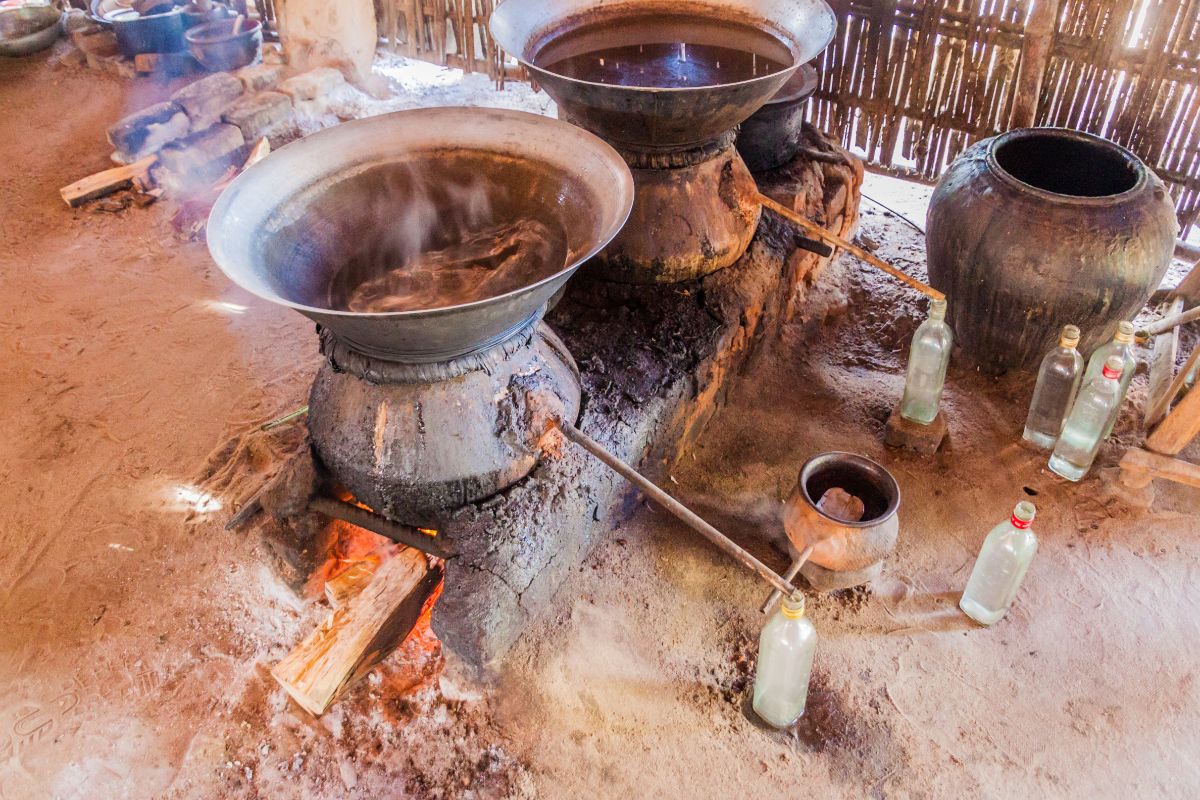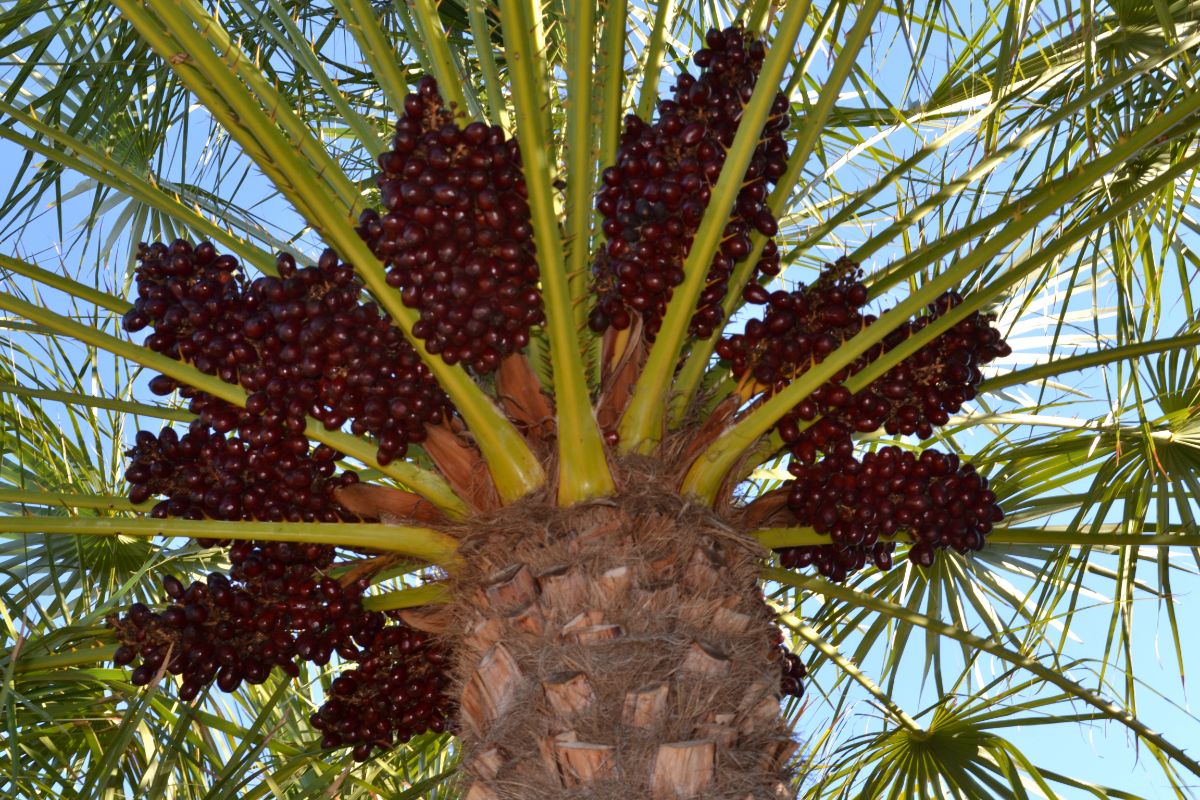Is a Palm Tree a Tree?
Yes, palm trees are among the most astonishing trees globally. How long do palm trees live? The age of palm trees differs based on their type, as you’ll find out later in this article.
There are different types of palm trees around the world. Also, a healthy palm tree’s life span is between seven and ten decades if you plant it in a suitable environment. That’s an extraordinary life span even for a tree, right?

The Palm Tree Lifespan
There are over 2,500 palm tree types with varying longevity. However, if you plant palm trees in unfavorable conditions or diseases and fungi attack them, they might not live long. Moreover, a palm tree growing in a cold environment may not blossom even if it looks healthy. Read our article and find out What Temperature Is Too Cold For Plants?
Also, since many palm trees grow in windy conditions, the wind fells them before reaching maturity. Hurricanes and storms usually tear them up and kill them, especially in coastal areas.
Nonetheless, a palm tree can survive up to 100 years growing in favorable conditions. Some may exceed a century, especially the healthy specimens. Moreover, palm trees grow to great heights, which need a long time which can partly explain their long lifespan.
Palm trees can easily outlive you! Therefore, think carefully before planting a palm tree on your ground. In this sense, it will help to know the life span of different palm tree species.
For example, the Mexican Fan Palm has an average of 100 years. Date Palms also live long, but because they grow tall, they are vulnerable to falling before reaching old age.
On the other hand, the Coconut Palm is slightly short-lived and is perhaps the most popular palm tree. It can live up to 90 years in favorable conditions. Also, they can grow up to 100 feet (30.48 meters) tall!
If you are looking for a palm tree with a short life span, consider the Areca Palm. The palm tree species live around 40 years and are smaller than the other palm trees.
These features make them popular for homeowners. However, because they are short-lived, you might have to replace them at some stage.
Oil palms are another short-lived species; people feel them when the fruits grow out of reach. If you don’t cut it down, it will live longer than 25 years.
It is also essential to remember that the palm tree life span has several stages. This next section breaks down the different palm tree growth stages. However, the stages may vary for different palms.
Stage 1: Germination
Like other plants, palms start with germination. The palm seed takes root at this stage, and you’ll find the plant has one leaf. The popular name for this stage is a monocot and all palms, regardless of their species, start this way.
In some instances, the seed experiences adjacent germination where the leaf emerges a little from the palm seed before the roots become visible. Alternatively, the seed can germinate remotely where the stem appears before the roots.
Stage 2: Vertical Growth and Caliper Growth
After germination, the palm will start growing. Your palm tree will spend several years growing vertically. This vertical growth is critical because the palm wants to get as close to the light as possible.
During vertical growth, new leaves will appear, and the truck will grow thicker. It will drop old leaves, and the plant will start resembling a miniature tree.
Additionally, the palm’s trunk will continue to widen and toughen to keep it upright. It expands its tissues to widen the stem and give it stability.
Stage 3: Flowering
Once the palm tree reaches maturity, it will start producing flowers during the warm weather. The palm flowers are tiny, and the palm does not produce them in great numbers.
While you can see clusters of these flowers from afar, they are not magnificent, and you could miss them. Some palm trees flower annually, while others flower and produce fruit after every few years. Other palm trees only flower once in their lifespan.
Don’t panic if your palm does not produce flowers and fruit often. Just ensure it remains healthy and has the proper color, and it will be fine.
Stage 4: Fruit Production
Your palm produces flowers to produce fruit. Suppose local pollinators successfully pollinate the palm tree; it will enter the fruit production stage. The popular local pollinators include insects and bats, depending on the type of palm tree you have.
You’ll see flower clusters forming into fruits. In some palm trees, you can harvest and eat the fruits. Suppose you don’t want to eat them; the local animals will consume them, so don’t fret!
Stage 5: End of Life
Do palm trees stop growing? Well, ultimately, your palm tree’s natural life will come to an end. However, this may happen after many decades; suppose you have a long-lived palm tree.
Regardless of how well you take care of your palm tree, it will eventually die. It will start losing leaves and no longer produce flowers and fruits at this stage.
Once your palm tree dies, it will likely fall because its root system becomes weak. Therefore, cut down a palm tree that has died to avoid any damage.
Facts About Palm Trees
These introductory statements must have stirred a hunger to find out more palm trees facts. Most of the time, people associate palm trees with tropical beaches with warm breezes. However, there is more to palm trees than the warm beaches. Here are some fascinating facts about palm trees you should know:
Palm Trees go way Back!
You can trace the history of palm trees from over 5,000 years ago to the Mesopotamian times. It was a popular food source and also provided construction material. Additionally, people used it as a source of shade from the scorching sun.
A Palm Tree Type can Grow 197 Feet (60.05 meters) Tall!
Quindio Wax Palm, the Columbian national tree, is among the tallest palm tree species. The tree is a native of Northern Peru and the Andes of Columbia tropical forests. It is also home to many animal species, such as the yellow-eared parrot.
Palm Trees Have Palmate or Pinnate Leaves
The palmate leaves grow like fingers on a hand starting from the stem’s end. On the flip side, pinnate leaves are feathery and grow along each side of a stem.
Palm Trees are a Source of Numerous Food Staples
It is an open secret that coconuts come from palm trees. However, you may not know that palm trees produce oil, betel nuts, acai fruit, and dates.
You Can Make Wine out of Palms
Have you heard of palm wine or Kallu? These are famous wines in some areas of Asia and Africa. The people make wine from different types of palms, such as coconut palms, date palms, and Chilean wine palms. It looks like you can make wine out of almost anything!

There are More Than 2,500 Palm Tree Species
Palm trees belong to the Arecaceae plant family. You can find these species in regions, including arid and tropical rainforests. The needle palm is the toughest type and can grow even in Alaska!
Not all Plants Called “Palms” are Trees Or Even Palms!
Palms usually grow as trees, woody vines, or shrubs. Famous plants like the yucca palm and sago palm don’t belong to the Arecaceae family. Hence they are not palms!
A Palm Tree Type has the Largest Seed
The Coco de Mer palm tree’s seeds are massive! Their weight is 60 pounds (27.22 kilograms) with a 20-inch (50.8 centimeters) diameter.
What do Palm Trees Produce?
The most common product you can get from palm trees is fruits. Coconuts are arguably the most common fruits that grow on palm trees.
Apart from coconuts, you can also get peaches, acai, and dates. However, if you keep your palm trees indoors, they wouldn’t live long enough to flower and produce fruits. Therefore, grow your palm trees outside to get any fruits.
Another popular product the palm tree produces is palm oil. You can get this oil from the fruit of oil palm trees and use it as vegetable oil. Many people call it the “miracle ingredient” for many products.
Additionally, palm oil accounts for a third of plant oil production globally. Palm oil is also significant in beauty products such as body lotions and soaps. It is also a popular ingredient in medicines, including cough syrups.
You can also produce beverages from palm trees. For example, Palm wine or palm toddy is a milky and sweet beverage you produce by fermenting sap of different palm species. The popular palm species for this purpose are coconut palms, date palms, and Palmyra.
Palms also produce the best wax available for the scented candles you love! Palm wax is popular because it is renewable, natural, and friendly to the environment.
Finally, you can also use palm trees for construction and crafts. Many use palm trees to build house walls, roofing, and rafters. You can pull apart the fibrous wood and weave it together to create thatch for roofing.
You can also use the palm tree leaves for roof thatching and garden fencing. Besides, you can use the leaves as nutritional feed for your livestock.
Do Palm Trees Stop Growing?
As mentioned earlier, the palm tree growth stages culminate with its death. Therefore, your palm tree will stop growing when it dies.
The critical question is, how can you tell that your palm tree is about to die, assuming you don’t know the tree’s age? Here are the signs that your palm tree has stopped growing and is nearing its death:
- The fronds will start to die back.
- The palm tree will stop flowering.
- The tree’s caliper may start to die off.
- It will stop producing new, vigorous growth.
What Does the Inside of a Palm Tree Look Like?
From a technical perspective, a palm tree is not a tree! When you cut through the trunk of a palm tree, don’t expect to see wood. Its caliper or stem contains tissues that make the tree sturdy and upright.
Additionally, the tree’s trunk can be single-stemmed or multi-stemmed. The stems have different textures; some are smooth while others are rough.
Palms also have nutrient-transport systems in their trunks, having xylem that transports water and minerals. Moreover, it also has the phloem, which transports carbohydrates.
However, the palm tree does continually replace its xylem and phloem. Instead, the two cells remain alive as long as the tree is still alive.
The palm tree does not have lateral branches. At the top of the palm stem, you’ll find the meristem where the tree produces its leaves and fruits.
How to Tell how old a Palm Tree is
Determining the age of a palm tree is not straightforward. There are different methods of calculating a palm tree’s age, but none works a hundred percent.
The traditional method of counting a tree’s rings to determine the phases of its growth will not work with palm trees. A palm tree’s trunk is not a trunk and is not wooden.
Instead, it has a cellular structure having fibrous strands in continuous lines. Additionally, they don’t have a bark, and you cannot classify them as wood.
In this regard, the best way to determine a palm tree’s age is by counting the number of frond scars it has. Since palm trees drop fronds as they grow older, many frond scars show the tree is mature, while a few wounds show that the tree is still young.
But, fronds grow at different rates per the prevailing conditions and the tree’s health. Additionally, they may also drop the fronds at different rates. For example, a palm tree growing in windy conditions may lose more fronds than one growing in a spot with shelter.
As a result, counting frond scars will only give you an approximate age of the tree. Unfortunately, this is the best way to tell the age of a palm.
You can couple this technique with looking at the tree’s height and estimating its age by how fast the tree is growing. However, remember that weather conditions significantly impact a palm’s growth rate.
The Best Palm Trees for homeowners
Remember, not all palm trees are ideal for homeowners. In fact, some palm trees are dangerous! Some palm tree species can stab you with sharp thorns, while others can expose you to harmful bacteria and fungi. Examples of dangerous palms include:
- Acrocomia Aculeate
- Copernicia Alba
- Phoenix Loureiro
- Aiphanes Minima
With that in mind, several palms are ideal for homeowners. Here are the popular types you should consider:
- Spindle Palms
- Jelly Palms
- Fan Palms
- Christmas Palms
- Bamboos
- Date Palms
- Princess Palms
- Areca Palms
- Canary Island Date Palms
- Bottle Palms

Parting Words
You must have witnessed the stunning beauty of palm trees, and you want the same beauty in your home garden. Fortunately, your dreams can come true!
Growing palm trees is reasonably straightforward, and if you follow the instructions, you’ll have fantastic trees in a couple of years. Having read this detailed article, you know how long the tree grows and the life stages.
Additionally, you are aware of all the exciting palm trees facts. You also know that some species are dangerous, and you shouldn’t plant them in your home. Luckily, there are many species you can plant in your home to add their beauty and, in some instances, boost your property’s value.
Do you have a property you want to beautify? Choose some palm tree species available in your region and plant them today!
